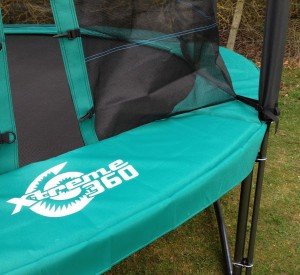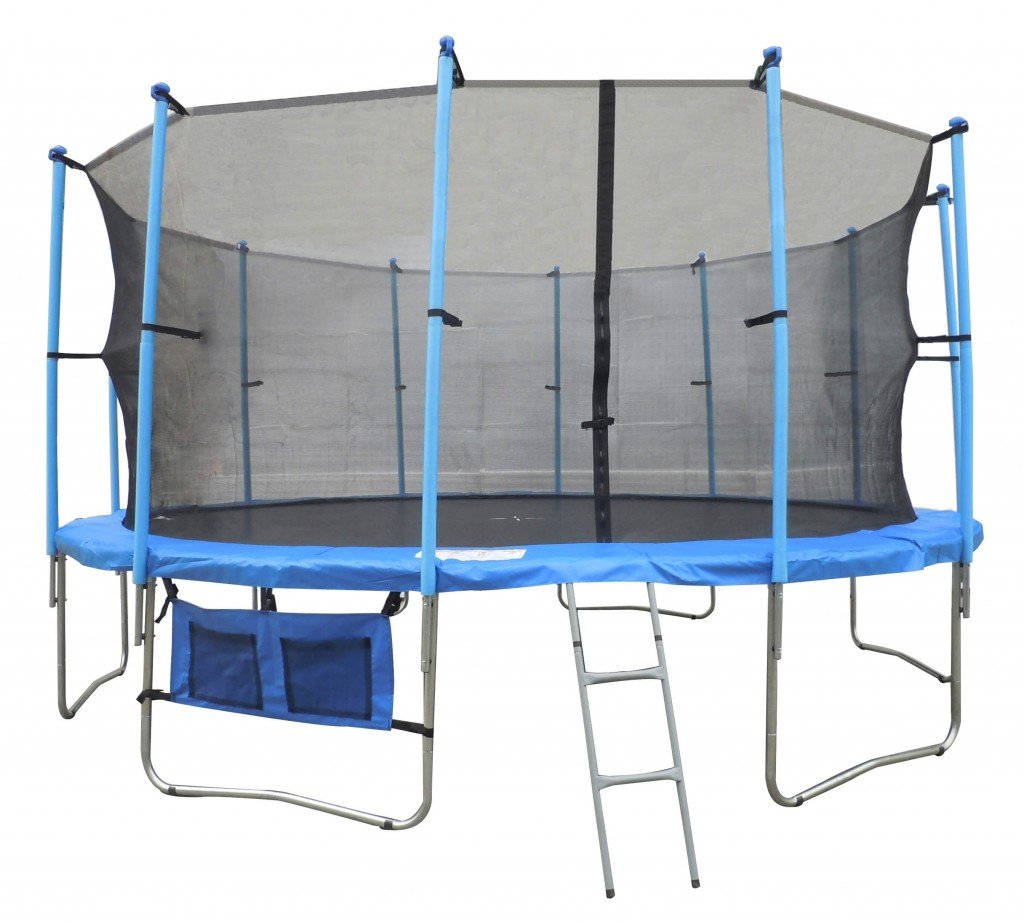Trampolines are a lot of fun, they are great for fitness and they’re popular with adults and children alike. However, some people are concerned about the safety of trampolines and in fact some people are so worried about trampolines that they are scared of buying one or even scared of letting their children use one. It it is true that you or your children could hurt themselves whilst using a trampoline, but if you follow standard health and safety procedures you’ll help prevent common accidents and ensure a fun and safe experience for everyone.
 1. Ensure Your Trampoline Has A Safety Enclosure
1. Ensure Your Trampoline Has A Safety Enclosure
Many trampoline accidents occur because the user falls off the trampoline mid-jump. Safety enclosures often look like large nets which zip open to allow access to the trampoline. These safety nets won’t prevent all injuries (you can still have a bad landing), but they will ensure that users do not find themselves flying onto the hard ground. Safety nets are recommended for almost all outdoor trampolines, including in-ground trampolines.
2. Supervise Your Children
Trampolines can be more dangerous for children then they are for adults. Not only are children smaller so a fall is likely to hurt them more, but some children also attempt to do tricks they aren’t ready for or they may get over excited and end up injuring themselves.
If you have smaller children (over the age of six) it’s important that you keep an eye on them when they use the trampoline and, if possible, remove any ladders and/or shut off access to the trampoline (e.g. lock the safety enclosure) to ensure that your children can’t use the trampoline unattended. Discourage your children from jumping on or off the trampoline onto the ground as this can cause obvious injuries. Children under the age of six may be better off with a trampoline which has been specially designed for smaller kids.
Kids love to play with their friends on a trampoline, but more than one person can disrupt the balance and cause injury. Make sure that only one child uses the trampoline as much as possible.
Encourage your children to stick to the middle of the mat and avoid the sides.
Don’t drink too much when using or supervising the trampoline! Many accidents happen at parties where the parents are intoxicated and not paying enough attention.
3. Weather Conditions
The downside to outdoor trampolines is that they are at the mercy of the elements and are likely to get wet fairly regularly. Don’ let your children jump on a wet trampoline as they are likely to slip and hurt themselves.
If the trampoline gets wet, make sure you thoroughly dry it and test it out before allowing your children to use it again. Also check it for fallen leaves, frost, snow and anything else.
4. Safety First
One of the most exciting things about a trampoline is that you can learn to perform impressive tricks on them, and you shouldn’t discourage your child from developing an interest in gymnastics or acrobatics if that is what they want to do. However, it is important to ensure they don’t start attempting complicated tricks which they don’t know how to perform to avoid injury. Things like somersaults can be very dangerous if they go wrong, so it’s very important to build a solid foundation and learn proper techniques before attempting anything more complicated.
If your child is dead set on learning trampoline tricks, start them off small with things like tuck, pike and straddle jumps to build up a foundation, and if your child is interested in learning a new trick try and enrol them in a gymnastics class (or if possible a trampoline class) so they learn proper form and techniques.
These same rules also apply to you. The most common trampoline injuries are a result of either falling off the trampoline or hurting yourself during a trick. Know your limits, learn the basics and build up to the final trick in stages. Don’t just leap into something you’re not ready for.
5. Placement
Your trampoline needs to be in a safe location which is not in close proximity to obstacles. Keep it away from trees, buildings, other play areas, ponds and anything which could feasibly cause an accident or result in someone hitting their head.
 It is unlikely that this would be a serious concern (especially if you have a safety net), but try to make sure that the trampoline is not near a fence to avoid the possibility or someone going flying into the street. The trampoline will need to be on a flat surface, in a clear area and be surrounded by a ‘safe fall zone’. Ensure that the ground around the trampoline is as soft as possible and it is not near anything hard or spiky.
It is unlikely that this would be a serious concern (especially if you have a safety net), but try to make sure that the trampoline is not near a fence to avoid the possibility or someone going flying into the street. The trampoline will need to be on a flat surface, in a clear area and be surrounded by a ‘safe fall zone’. Ensure that the ground around the trampoline is as soft as possible and it is not near anything hard or spiky.
It is vital to ensure that the trampoline is stable, on a flat surface and is not going to wobble or fall over. Make sure there is nothing underneath the trampoline either as the mat moves up and down and, if there is something underneath, it could easily cause injury.
6. Equipment
Trampolines are bouncy because they include springs. These springs can break over time (and as a result of too much weight and overuse), so it’s important to make sure that the trampoline has enough springs to stop it sagging and potentially breaking.
These springs can sometimes fall upwards when they break and this could potentially cause injury, so it’s a good idea to make sure the spring are tight before using the trampoline.
You should also ensure there is a safety pad over the hooks, springs and frame of the trampoline to avoid someone landing on anything hard or sharp. Most trampolines will come with a safety pad, but make sure it is made out of good quality material and replace it if it becomes damaged over time.
Read your safety manual to ensure you know everything you need to know about the trampoline.
7. Remove Sharp Objects
When you (or your children) are jumping on a trampoline there is a reasonable chance that someone is going to fall over onto the mat. This isn’t a problem in itself, but it’s important to make no one is wearing anything sharp or has anything sharp in their pockets which could cause potential injury if it was fallen on.
